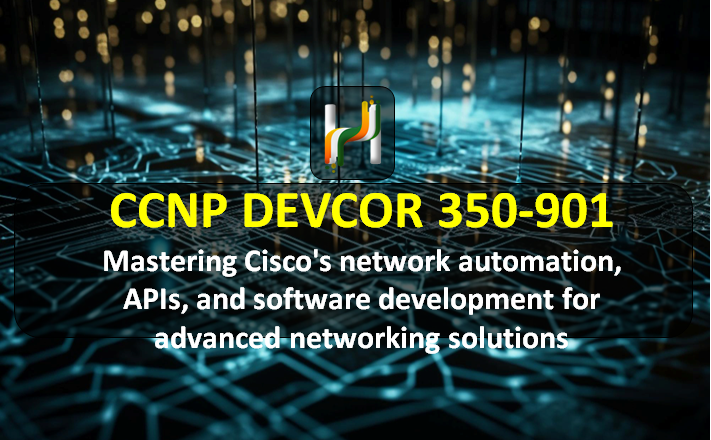Hind Networks is not only providing assistance to the candidates for their certification exams but also for their career success. The world-class Cisco Certified DevNet Professional Training institute in India, Hind Networks is providing DevNet Professional Training in Mumbai, India. To achieve DevNet Professional certification, the candidate will not have to pass more than 2 exams. Any additional specializations are most welcome but the candidate needs to pass a core exam and one of the concentration exam options available in the respective track and in line with other Professional certifications. Besides the DevNet Professional, core exam also acts as qualifying criteria for attempting the Cisco Certified DevNet Expert lab exam. The Cisco DevNet Certification program will establish your skills in areas for instance Cisco APIs, Cisco’s programmability, security, strategy, and network ops. This program is targeted at software developers, DevOps engineers, automation specialists, and other software professionals. For employers, DevNet certification will indicate verifiable skills in the domains of automation, infrastructure as code, IoT, DevOps, and Webex. Ideally, DevNet Professional candidates also have three to five years of experience with software development including Python programming
CCNP DEVCOR 350-901

Following is the list of DevNet Concentration exam:
300-435 – Implementing Automation for Cisco Enterprise Solutions (ENAUI)
300-835 – Implementing Automation for Cisco Collaboration Solutions (CLAUI)
300-635 – Implementing Automation for Cisco Data Center Solutions (DCAUI)
300-535 – Implementing Automation for Cisco Service Provider Solutions (SPAUI)
300-735 – Implementing Automation for Cisco Security Solutions (SAUI)
300-910 – Implementing DevOps Solutions and Practices using Cisco Platforms (DEVOPS)
300-915 – Developing Solutions using Cisco IoT and Edge Platforms (DEVIOT)
300-920 – Developing Applications for Cisco Webex and Webex Devices (DEVWBX)
The DevNet track exam is divided into two parts: The core exam and the concentration exam. Having helped a lot of students achieve their CCNP and CCIE certification goals, Hind Networks has acquired the trust and faith of many CCNP and CCIE aspirants.
Software Development and Design
-
1Describe distributed applications related to the concepts of front-end, back-end, and load balancing
-
2Evaluate an application design considering scalability and modularity
-
3Evaluate an application design considering high-availability and resiliency (including onpremises, hybrid, and cloud)
-
4Evaluate an application design considering latency and rate limiting
-
5Evaluate an application design and implementation considering maintainability
-
6Evaluate an application design and implementation considering observability
-
7Diagnose problems with an application given logs related to an event
-
8Evaluate choice of database types with respect to application requirements (such as relational, document, graph, columnar, and Time Series)
-
9Explain architectural patterns (monolithic, services oriented, microservices, and event driven)
-
10Utilize advanced version control operations with Git
-
11Explain the concepts of release packaging and dependency management
-
12Construct a sequence diagram that includes API calls
Using APIs
-
13Implement robust REST API error handling for time outs and rate limits
-
14Implement control flow of consumer code for unrecoverable REST API errors
-
15Identify ways to optimize API usage through HTTP cache controls
-
16Construct an application that consumes a REST API that supports pagination
-
17Describe the steps in the OAuth2 three-legged authorization code grant flow
Cisco Platforms
-
18Construct API requests to implement chatops with Webex API
-
19Construct API requests to create and delete objects using Firepower device management (FDM)
-
20Construct API requests using the Meraki platform to accomplish these tasks
-
21Construct API calls to retrieve data from Intersight
-
22Construct a Python script using the UCS APIs to provision a new UCS server given a template
-
23Construct a Python script using the Cisco DNA center APIs to retrieve and display wireless health information
-
24Describe the capabilities of AppDynamics when instrumenting an application
-
25Describe steps to build a custom dashboard to present data collected from Cisco APIs
Application Deployment and Security
-
26Diagnose a CI/CD pipeline failure (such as missing dependency, incompatible versions of components, and failed tests)
-
27Integrate an application into a prebuilt CD environment leveraging Docker and Kubernetes
-
28Describe the benefits of continuous testing and static code analysis in a CI pipeline
-
29Utilize Docker to containerize an application
-
30Describe the tenets of the "12-factor app"
-
31Describe an effective logging strategy for an application
-
32Explain data privacy concerns related to storage and transmission of data
-
33Identify the secret storage approach relevant to a given scenario
-
34Configure application specific SSL certificates
-
35Implement mitigation strategies for OWASP threats (such as XSS, CSRF, and SQL injection)
-
36Describe how end-to-end encryption principles apply to APIs
Infrastructure and Automation
-
37Explain considerations of model-driven telemetry (including data consumption and data storage)
-
38Utilize RESTCONF to configure a network device including interfaces, static routes, and VLANs (IOS XE only)
-
39Construct a workflow to configure network parameters with:
-
40Identify a configuration management solution to achieve technical and business requirements
-
41Describe how to host an application on a network device (including Catalyst 9000 and Cisco IOx-enabled devices)








